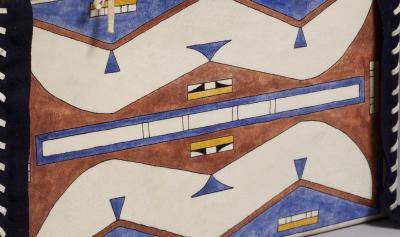Box
- Debra Box, Southern Ute, American, 1956 -
- Work Locations: Colorado
For more than twenty-five years, Debra Box has been reviving the almost-lost art of making parfleches (rawhide containers). She has received many awards for her artwork and represented the Southern Ute Nation at the grand opening of the Smithsonian’s National Museum of the American Indian in 2004. In addition to making parfleches, she also does bead and quill work. Her creations have found their way into such movies as Dances with Wolves and are offered for sale in galleries and at the Santa Fe Indian Market every August.
Plains and western Indians made containers out of treated animal hides to store or carry items like moccasins, clothing, or dried food. French traders called these boxes parfleches, from the French words parer, meaning “parry” or “defend,” and flèche, meaning “arrow,” because the hide was tough enough to deflect an arrow.
Debra Box became interested in making parfleches when she began to travel with her late husband to mountain man rendezvous, where they would stay in a tipi they tried to keep authentic to the pre-1840s fur-trading period. After much research and conversations with her grandmother, Box learned the month-long process of tanning, shaping, and decorating animal hides to make a parfleche.
Although Box uses traditional techniques and bases her designs on objects in museum collections, photographs, and books, her parfleches are her own unique artistic creations. “My rawhide painting reflects my Ute heritage but in an abstract and contemporary form,” she says.
Details

Material
Debra Box makes her parfleches out of cowhide that she buys from a slaughter house and cleans by soaking in water and detergent. She ties the hide to a wooden frame and leaves it in the sun to dry. Once the hide is dry, Box uses a metal scraper to scrape off the hair and fatty tissue—a process that takes three full days. She sets the hide out in the sun again until it is white, turning it every few days so it bleaches evenly. After a few weeks, the hide is stiffened and ready for her to cut and shape with a wooden mallet.

Leather Ties
Box fastens the edges of her parfleches with leather ties made from deer hide she tans herself. She describes the tanning process as “very labor intensive…I’ve never done this work but if you’ve done it right your hide will be as soft as velvet. This is [also] the kind of hide that I buy for my beadwork. The beading needles won’t break.”

Dark Blue Trade Cloth
The material on the four side edges is modern-day trade cloth. Box doesn’t normally add fabric, but she did on this piece—made especially for the Denver Art Museum—to add color and texture, and because the museum’s curator requested it. “When the fur traders came to the West they brought glass beads, trade beads, metal pots, guns and trade cloth. A trade cloth dress was a sign of wealth,” Box says.

Colors
Box uses three colors in this particular work: ochre, red, and blue, plus small amounts of black for accents and outlines. In traditional Southern Ute art, blue symbolizes mountain slopes and big predatory animals like the grizzly bear, wolf, and coyote; red signifies spring, bodies of water, and the weasel’s domain; and yellow represents summer or the mountain lion’s domain. The black outline stands for winter and the rattlesnake’s domain, while the white background represents the sky and the eagle’s domain.
More Resources
Ute Indians
This video shows the history of the Ute Indians and their oppression by white settlers.
Colorado and the West: Native American History in Colorado
A few American Indians from various cultural backgrounds talk about how American Indians are still relevant today and not solely a culture of the past.
Websites
Welcome to Ancient Nations: Indigenous Art of the American West
This website talks about parfleche, Debra Box’s process in creating her parfleche containers, and her work in general.
Native American Trading Company: A Gallery of Fine Southwest and Native American Art
Debra Box at the Native American Trading Company. This site highlights her accomplishments and her work.
Southern Ute Indian Tribe
Official website for Southern Ute Indian Tribe
Plains Indian Parfleche
Instructional information on how parfleche containers were made and an art project for making your own.
Books
Wroth, William. Ute Indian Arts and Culture: From Prehistor y to the New Millenium. Colorado Springs, Colorado: Taylor Museum of the Colorado Springs Fine Arts Center, 2000.
Overview of Ute life; particularly that of the Southern Utes. Examples of Debra Box’s work can be found on pages 234-235 and 219-220. Early examples of and information about Parfleche can be found on pages 118-119 and 148-149.
Wood, Nancy. When Buffalo Free the Mountains. Garden City, New York: Doubleday and Company, Inc, 1980.
This book tells of how the loss of Native lands to white men for over one hundred years, continues to this day to impact the Ute Mountain Ute, and Southern Ute tribes.
Funding for object education resources provided by a grant from the Morgridge Family Foundation. Additional funding provided by the William Randolph Hearst Endowment for Education Programs, and Xcel Energy Foundation. We thank our colleagues at the University of Denver Morgridge College of Education.
The images on this page are intended for classroom use only and may not be reproduced for other reasons without the permission of the Denver Art Museum. This object may not currently be on display at the museum.
